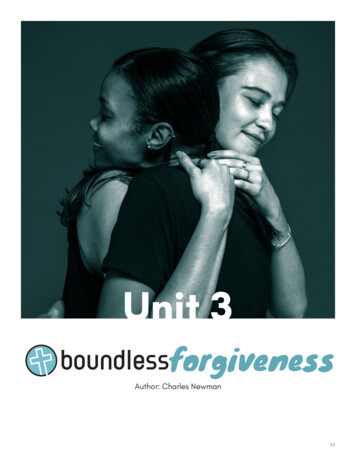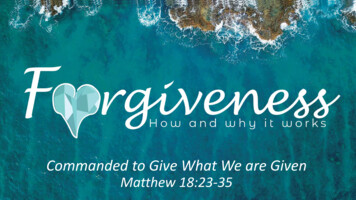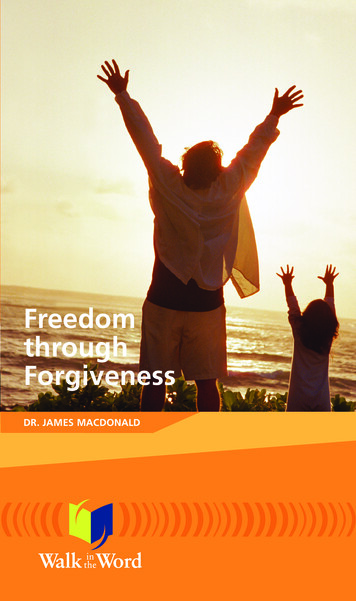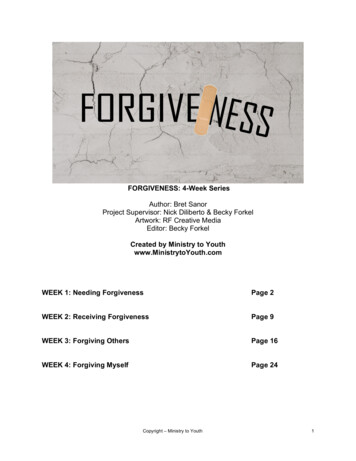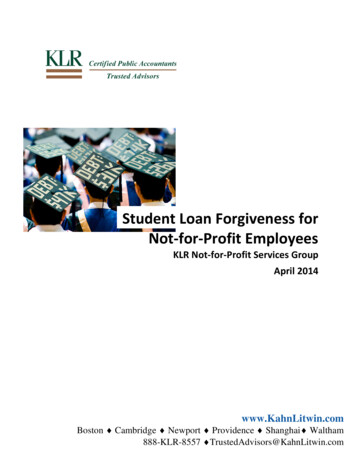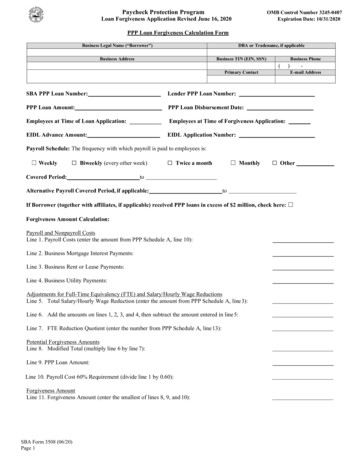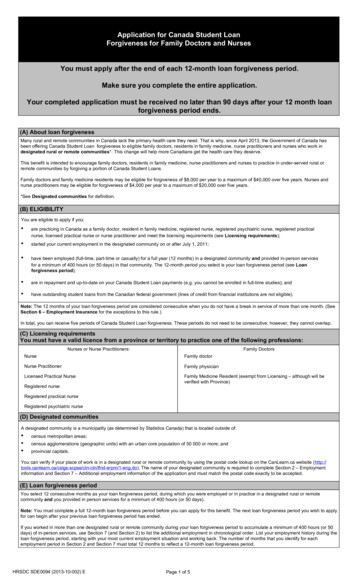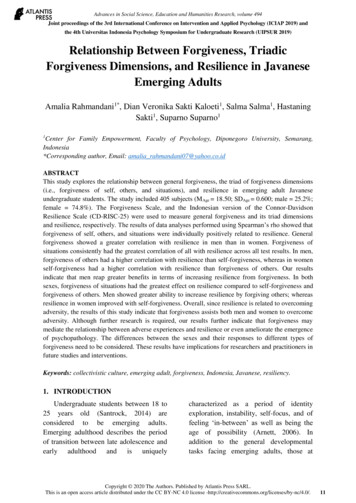
Transcription
Advances in Social Science, Education and Humanities Research, volume 494Joint proceedings of the 3rd International Conference on Intervention and Applied Psychology (ICIAP 2019) andthe 4th Universitas Indonesia Psychology Symposium for Undergraduate Research (UIPSUR 2019)Relationship Between Forgiveness, TriadicForgiveness Dimensions, and Resilience in JavaneseEmerging AdultsAmalia Rahmandani1*, Dian Veronika Sakti Kaloeti1, Salma Salma1, HastaningSakti1, Suparno Suparno11Center for Family Empowerment, Faculty of Psychology, Diponegoro University, Semarang,Indonesia*Corresponding author, Email: amalia rahmandani07@yahoo.co.idABSTRACTThis study explores the relationship between general forgiveness, the triad of forgiveness dimensions(i.e., forgiveness of self, others, and situations), and resilience in emerging adult Javaneseundergraduate students. The study included 405 subjects (MAge 18.50; SDAge 0.600; male 25.2%;female 74.8%). The Forgiveness Scale, and the Indonesian version of the Connor-DavidsonResilience Scale (CD-RISC-25) were used to measure general forgiveness and its triad dimensionsand resilience, respectively. The results of data analyses performed using Spearman’s rho showed thatforgiveness of self, others, and situations were individually positively related to resilience. Generalforgiveness showed a greater correlation with resilience in men than in women. Forgiveness ofsituations consistently had the greatest correlation of all with resilience across all test results. In men,forgiveness of others had a higher correlation with resilience than self-forgiveness, whereas in womenself-forgiveness had a higher correlation with resilience than forgiveness of others. Our resultsindicate that men reap greater benefits in terms of increasing resilience from forgiveness. In bothsexes, forgiveness of situations had the greatest effect on resilience compared to self-forgiveness andforgiveness of others. Men showed greater ability to increase resilience by forgiving others; whereasresilience in women improved with self-forgiveness. Overall, since resilience is related to overcomingadversity, the results of this study indicate that forgiveness assists both men and women to overcomeadversity. Although further research is required, our results further indicate that forgiveness maymediate the relationship between adverse experiences and resilience or even ameliorate the emergenceof psychopathology. The differences between the sexes and their responses to different types offorgiveness need to be considered. These results have implications for researchers and practitioners infuture studies and interventions.Keywords: collectivistic culture, emerging adult, forgiveness, Indonesia, Javanese, resiliency.1. INTRODUCTIONUndergraduate students between 18 to25 years old (Santrock, 2014) areconsidered to be emerging adults.Emerging adulthood describes the periodof transition between late adolescence andearly adulthood and is uniquelycharacterized as a period of identityexploration, instability, self-focus, and offeeling ‘in-between’ as well as being theage of possibility (Arnett, 2006). Inaddition to the general developmentaltasks facing emerging adults, those atCopyright 2020 The Authors. Published by Atlantis Press SARL.This is an open access article distributed under the CC BY-NC 4.0 license -http://creativecommons.org/licenses/by-nc/4.0/.11
Advances in Social Science, Education and Humanities Research, volume 494university undergo a variety of uniqueexperiences compared with those whodecide not to continue their education to ahigher level. These experiences includechanges in social and family relations andsocio-economic status, as well asseparation from family and friends due tostudying far from home. The search foridentity and the formation of self-conceptare common issues facing emerging adultsstudying at university (Adams, Meyers, &Beidas, 2016; Elias, Ping, & Abdullah,2011).The personal histories and adverseevents they may have experienced duringchildhood and adolescence all play a rolein the way undergraduate students adjustduring the emerging adulthood period. Thedata shown in Table 1 represent theadverse childhood experiences reported instudy of Indonesian undergraduatestudents (Salma, Kaloeti, Rahmandani,Sakti, & Suparno, 2019). The number ofadverse events experienced by subjects inthe study ranged from 0 to 7. Mostsubjects (54.2%) claimed to have had noadverse childhood experiences, whereas30.1% reported one adverse childhoodexperience during the first 18 years of life.Bullying was the most common ergraduatesubjects(33.2%), followed by emotional abuse(8.8%), physical abuse (6.9%), parent(s)passed away (6.9%), and emotionalneglect (5.7%).Table 1. Prevalence of Adverse Childhood Experiences’ Types among Indonesian UndergraduateSamples (n 419)Adverse Childhood Experiencesf%Emotional abuse378.8Physical abuse296.9Sexual abuse92.1Emotional neglect245.7Physical neglect61.4Living in family with parents separated or divorced122.9Living in family with domestic violence71.7Living with family member with alcohol or substance abuse problem51.2Living with family member with mental health problems133.1Having incarcerated family member102.4Bullying13933.2Parent(s) passed away296.9Source: (Salma et al., 2019)As both present and past experiencesaffect current mental health, undergraduatestudents, who have experienced prioradversity, may find it difficult to makepersonal, social (Adams et al., 2016;Horgan, Sweeney, Behan, & Mccarthy,2016), and academic adjustments (Elias etal., 2011). In addition to worseningphysical condition (Kalmakis & Chandler,2015), these students may also experiencemental health issues such as stress,anxiety, depression (Chernomas &Shapiro, 2013; Iqbal, Gupta, &Venkatarao, 2015), substance abuse12
Advances in Social Science, Education and Humanities Research, volume 494(Skidmore, Kaufman, & Crowell, 2016),and other forms of symptomatology(Adams et al., 2016; Benjet, Borges, &Medina-mora, 2010; Dvir, Ford, Hill, &Frazier, 2014). Furthermore, studentsexperiencing the mental health problemsmay influence others, resulting in anincrease in mental health issues within thecohort (Cranford, Eisenberg, & Serras,2009). Specific evidence relating toparental child-rearing strategies indicatesthat these strategies also affect selfregulation, socio-emotional adjustment,and psychopathology in early adulthood(Baker & Hoerger, 2012). The greater theadversity experienced during childhoodand adolescence, the greater likelihood ofdepression in emerging adulthood.Emerging adults having experienced highlevels of adversity have been shown to be2.5 times more likely to suffer fromdepression in later life (Salma et al., 2019).Resilience plays a crucial role inachieving the requisite adjustments duringemerging adulthood and has been shownto be a reliable predictor of higheracademic performance than demographicvariables. It further results in greater hope(Ayyash-Abdo, Sanchez-Ruiz, & Barbari,2016), lower psychological distress, betteradjustment, higher life satisfaction (Liu,Wang, Zhou, & Li, 2014), increasedvirtues, better posttraumatic growth (Duan,Guo, & Gan, 2015), and better mentalhealth (Hartley, 2011).Some studies have demonstrated thatstressful experiences foster resilience(Wilks & Spivey, 2010), and resilience hasbeen shown to moderate the relationshipbetweenchildhoodadversityanddepression (Poole, Dobson, & Pusch,2017) as well as between childhoodadversity and mental health (Logan-Greene, Green, Nurius, & Longhi, 2014).However, the opposite results wereobtained in a study involving Indonesianundergraduate students. This study foundthat adverse childhood experiences weremore likely to result in depressivesymptoms rather than fostering resilience(Kaloetietal.,2019).Amongundergraduate students, resilience partiallymediated the relationship betweenpsychological distress and depressivesymptoms but not to the same extent thatchildhood traumas led to depressivesymptoms.Considering how traumas impact lowself-acceptance (Schulz et al., 2017), selfcriticism and self-punishment (Kaess et al.,2013), and social dysfunction (Bruce,Heimberg, Blanco, Schneier, & Liebowitz,2012), it is an important to study therelationship between forgiveness andtrauma. In the act of forgiveness, peopleacknowledge that a transgression (an eventthat people perceive as violating theirexpectations and assumptions about howthey, other people, or the world ‘‘ought’’to be) has occurred, and then carry out thecognitive, emotional, and/or behavioralwork needed to reframe the transgressionso that it is no longer perceived as negative(L. Y. Thompson et al., 2005). It is clearthat transgressors are not limited to othersbut can also be oneself or situationsbeyond one's control. Forgiveness hasbeen shown to have an impact on themental and physical health of peopleduring stress exposure experiences (L.Toussaint, Shields, Dorn, & Slavich,2014). Forgiveness also has an impact onposttraumatic growth in people who haveexperienced adveristy (Laufer, RazHamama, Levine, & Solomon, 2009). Theforgiveness of transgressions in romantic13
Advances in Social Science, Education and Humanities Research, volume 494relationships has been shown to lead toincreased commitment to the relationshipby those who forgive (Ysseldyk & Wohl,2012).Previous studies have examined howforgivenesspredictsresilienceinadolescents (Mary & Patra, 2015), adults(Broyles, 2005), undergraduate students(Gupta & Kumar, 2015; Kumar & Dixit,2014), and other specific populationgroups (Abid & Sultan, 2015; Hee &Mihyoung, 2014; Waldron, Braithwaite,Oliver, Kloeber, & Marsh, 2018).Previous studies have shown thatforgiveness differs between collectivisticand individualistic cultures. Specifically,the focus of attention on self or othersassociated with forgiveness differs for thetwo culture types. Table 2 shows howforgiveness, especially self-forgivenessand forgiveness of others, is defined in thecollectivistic and individualistic cultures(Sandage & Williamson, 2005).Table 2. Comparisons of Individualistic and Collectivistic Worldviews in Relations to ForgivenessFactor ViewedIndividualistic WorldviewCollectivistic WorldviewView of selfIndependent, self-reflexiveInterdependent, sociallyembeddedView of alPrimary face concernSelf-faceOther-face and self-faceForgiveness and reconciliationSharply distinctClosely relatedValue of self-forgivenessHighLowCentral goal of forgivenessPersonal well-beingSocial well-beingPrimary tools for forgivenessProfessional psychotherapy,Communal mediators/healers,self-help resources, andnarratives, rituals, andindividual coping skillssymbolsSource: (Sandage & Williamson, 2005)The relationship between forgivenessand resilience has yet not been adequatelybeen described in terms of the s of others, and forgiveness ofsituations. In addition, although it ispossible to forgive situations beyond one'sown control, evidence of this remainslimited compared to self-forgiveness andforgiveness of others (Mullet, Neto, &Rivière, 2005).Hence,thisstudyseekstocomprehensively examine the relationshipbetween these three dimensions offorgiveness and resilience; specifically,within the emerging adult developmentalperiod and the culture of a single ethnicgroup in a collectivistic country, namelythe Javanese of Indonesia.Java is one of the ethnicities inIndonesia, and the Javanese self-concept isbased on a prototype description of theJavanese as individuals who enjoy andstrive to achieve harmony in a shared life(Susetyo, Widiyatmadi, & Sudiantara,2014). Accordingly, harmony must alwaysbe sought when interacting with others andin social life in general. Respect is amandatory part of behavior toward others,particularly those who are older or have ahigher position. For Javanese ‘rasa’(literally in English is feeling or emotion)has an important role, especially in thesocial realm, where it is evidenced as the14
Advances in Social Science, Education and Humanities Research, volume 494subtlety of behavior (Jatman, 2011). InJavanese people are never singleindividuals, ‘Aku’ (‘I’), but there arealways others (Jatman, 2011). ‘Mawasdiri’ (‘Introspection’) is very important inJava, as it leads one to the right path, toself-understanding, self-surrender, andfinally self-awareness (Jatman, 2011).Patriarchy is upheld in the Javaneseculture, hence men are considered to holda higher social position than women(Hermawati, 2007).This culture milieu indicates thatforgiveness may play an important role inimproving resilience and preventingmental health problems in Javaneseundergraduate emerging adults. Furtherinvestigation into the types of forgiveness,the period and developmental tasks, andthe inherent culture – in this case Javaneseculture – is required. Forgiveness andincreased resilience may help Javaneseundergraduate emerging adults to dealwith difficult situations that have not beensufficiently addressed both in the past andin the present. This study used aquantitative cross-sectional method toexaminetherelationshipbetweenforgiveness as a whole and also betweenthe triadic dimensions of forgiveness andresilience in Javanese undergraduateemerging adults.We hypothesized that there are positiveand significant relationships betweenforgiveness,itsdimensions(selfforgiveness, forgiveness of others, andforgiveness of situations), and resilience inJavanese undergraduate emerging adults.We carried out data analyses in order toobtain comprehensive results.2. METHODS2.1. ParticipantsThis study involved 405 Javaneseundergraduate students from DiponegoroUniversity who were categorized asemerging adults based on their ages whichfell in the range of 18–22 years (MAge 18.50; SDAge 0.600; male 25.2% [MAge 18.53; SDAge 0.671]; female 74.8%[MAge 18.49; SDAge 0.575]). Themajority (96.8%) of the subjects in thisstudy were aged 18–19 years and in thefirst year of their study (including studentsfrom the Faculty of Sciences andMathematics [36.1%], Faculty of PublicHealth [22.7%], Faculty of Psychology[17.0%], Faculty of Economics andBusiness [14.8%], and Faculty ofEngineering [9.4%]).2.2. ProceduresAfter obtaining permission fromstudents in several faculties at DiponegoroUniversity. Participants were volunteersand data collection were carried out givingdue consideration to the lecture schedulesof first year students. Once thepsychological scales were completed, thedata were scored, entered, and reduced onthe basis of any unmet criteria. Data fromjust 405 (61.27%) of the 661 respondentsinvolved in this study could be furtherexamined. Data from 256 (32.73%) couldnot be processed due to incompleteresponses or because they came fromethnic groups other than Javanese.2.3. Measures2.3.1. Demographic l scale was used to collectinformation regarding the participants’ethnicity, sex, age, faculty, and majorsubject.15
Advances in Social Science, Education and Humanities Research, volume 4942.3.2. ForgivenessForgiveness was measured using aforgiveness scale developed based on (L.Y. Thompson et al., 2005). This scalemeasures general forgiveness, as well asthe dimensions of forgiveness, namelyself-forgiveness, forgiveness of others, andforgiveness of situations. The whole scaleconsists of 48 items of which 40 itemsmeasure general forgiveness (Cronbach'salpha 0.912), 14 items measure selfforgiveness (Cronbach's alpha 0.764), 19items measure forgiveness of others(Cronbach's alpha 0.884), and 13 itemsmeasureforgivenessofsituations(Cronbach's alpha 0.832). TheForgiveness Scale is a Likert scale withfour-point responses ranging from‘strongly disagree’ to ‘strongly agree’.Scores on favorable items range from 0 for'strongly disagree' to 3 for 'strongly agree',and vice versa for unfavorable items. Totalscore is the sum of the scores of all itemson the scale or subscales.2.3.3. ResilienceThe Connor-Davidson Resilience Scale(CD-RISC-25) (Connor & Davidson,2003) was used to measure resillience. TheCD-RISC-25 is a 25-item scale with a 5point Likert response type, ranging from 0for ‘not true at all’ to 4 for ‘true nearly allthe time’. Cronbach's alpha in this studywas 0.89. The total score is obtained byadding up all the item scores on the scale.were not normal, non-parametric statisticaltests were performed. The bivariatecorrelation tests were performed usingSpearman's rho. Further statistical testswere also carried out to provide supportfor the results obtained. The partialcorrelation tests were conducted to observethe correlation between forgiveness, thetriadic forgiveness dimensions, andresilience by controlling for sex and age,both separately and together. Wilcoxonsigned rank tests were used to examine thedifference in mean scores betweenvariables of the triadic forgivenessdimensions. The Mann-Whitney andKruskal-Wallis tests were also used tomeasure the significance of the meandifference in the scores of each variablebased on sex and age. All tests wereperformed using the Statistical Packagesfor Social Science version 22 (SPSS 22).3. RESULTSTable 3 shows the demographic data ofthe 405 participants in this study. Of thestudy cohort 74.8% were women(MAge 18.49; SDAge .575), and the restwere men (MAge 18.53; SDAge 0.671).The age range of participants was 18–22years (MAge 18.50; SDAge 0.600), withthe majority (96.8%) of participants aged18–19 years. The mean and standarddeviation of the scores of each variable ofdemographic data are also listed forcomparison in Table 3.2.4. Data AnalysisThis quantitative cross-sectional studyused a correlational approach. As theresults of normality testing usingKolmogorov-Smirnov on all variables16
Advances in Social Science, Education and Humanities Research, volume 494Table 3. Demographic Data of Participants and Descriptive Statistics of VariablesDescriptive alForgivenessofResilienceForgivenessof OthersCharacteristics(%)SituationsMeStD MeStDe MeStD MeStD MeStDanevanvanevanevanevSexMale102 70.9 14.14 24.035.622.269.3 12.174.7288.7005.211(25.2)6092101Female303 71.5 12.43 24.535.822.369.4 11.214.6696.8014.868(74.8)9736510Age (years old)18220 70.9 12.99 24.235.722.168.7 11.43(54.3)952 4.6358 6.9553 5.0088219172 71.9 12.17 24.536.022.469.9 11.65(42.5)809 4.8000 7.4143 4.713732010 (2.5) 72.8 21.74 26.633.3 12.85 24.272.1000 3.471090 7.8290 9.279212 (0.5) 62.520.031.521.072.50 4.9500 1.4140 3.5360 1.4140 7.778221 (0.3)8026402569Total405 71.4 12.87 24.435.822.369.3 11.444.6827.3154.950(100)3220184The results of data analyses performedusing Spearman's rho are shown in Table4. These findings indicated that the threedimensions of forgiveness (forgiveness ofself, others, and situations) wereindependently positively and significantlyrelated to resilience (rxy 0.346, p 0.000;rxy 0.350, p 0.000; rxy 0.391, p 0.000,respectively).Table 4. Correlation between Forgiveness, the Triadic Dimensions of Forgiveness, and ResilienceResilience123rxyprxyprxyprxyp**1. Forgiveness.432.000**2. Self-Forgiveness.346.000 .677** .0003. Forgiveness of Others.350** .000 .801** .000 .295** .0004. Forgiveness of Situations.391** .000 .842** .000 .615** .000 .503** .000Male1. Forgiveness.453** .0002. Self-Forgiveness.327** .001 .549** .0003. Forgiveness of Others.397** .000 .822** .000 .168 .0924. Forgiveness of Situations.400** .000 .831** .000 .533** .000 .497** .00017
Advances in Social Science, Education and Humanities Research, volume 494Resiliencerxyp1rxy2prxy3prxyFemale1. Forgiveness.419** .0002. Self-Forgiveness.349** .000 .717** .0003. Forgiveness of Others.327** .000 .789** .000 .333** .0004. Forgiveness of Situations.383** .000 .847** .000 .639** .000 .502**Notes. **Correlation is significant at the 0.01 level (two-tailed); 1 Forgiveness; 2 SelfForgiveness; 3 Forgiveness of Others.General forgiveness correlated withresilience by as much as rxy 0.432 (p 0.000). Even after being controlled for sexand age, both separately and together,these correlations remained significant (p 0.000) as shown in Table 5.Forgiveness of situations had thehighest correlation of all to resilience. Thiswas followed by self-forgiveness, andforgiveness of others consistently showedthe lowest correlation with resilience1.2.3.4.1.2.3.4.1.2.3.4.p.000across all tests, especially after controllingfor sex and age. When the dimensions offorgiveness were tested against each other,apart from revealing a positive andsignificant relationship, tests of thecorrelation between self-forgiveness andforgiveness of others were always theweakest compared to the correlationsamong other dimensions of forgiveness(Akoglu, 2018).Table 5. Correlation between Forgiveness, the Triadic Dimensions of Forgiveness, and Resilienceafter Controlling for Sex and AgeResilience123Control VariablesrxyprxyprxyprxypSexForgiveness.424** .000Self-Forgiveness.350** .000 .684** .000Forgiveness of Others.313** .000 .813** .000 .255** .000Forgiveness of Situations.388** .000 .873** .000 .648** .000 .522** .000AgeForgiveness.423** .000Self-Forgiveness.348** .000 .683** .000Forgiveness of Others.314** .000 .814** .000 .256** .000Forgiveness of Situations.386** .000 .873** .000 .647** .000 .524** .000Sex & AgeForgiveness.423** .000Self-Forgiveness.348** .000 .683** .000Forgiveness of Others.314** .000 .814** .000 .256** .000Forgiveness of Situations.386** .000 .873** .000 .647** .000 .523** .000Notes. **Correlation is significant at the 0.01 level (two-tailed); 1 Forgiveness; 2 SelfForgiveness; 3 Forgiveness of Others.Table 4 also shows that in both menand women, forgiveness and the triadic18
Advances in Social Science, Education and Humanities Research, volume 494forgiveness dimensions were positivelyand significantly correlated with resilience.Although there was greater correlation inmen (rxy 0.453, p 0.000) than inwomen (rxy 0.419, p 0.000). Also, inmen forgiveness of others had a highercorrelation with resilience than selfforgiveness,whereasinwomen,forgiveness of others had a lowercorrelation with resilience than selfforgiveness. Nevertheless, the correlationbetween forgiveness of situations had thehighest correlation with resilience of allthe dimensions of forgiveness in bothsexes. Additionally, no significantcorrelation was found between selfforgiveness and forgiveness of othersamongmaleparticipants.Table 6. Descriptive Statistics of Triadic Dimensions of Forgiveness after AdjustmentDescriptive Statistics after AdjustmentSelf-ForgivenessForgiveness ofForgiveness DevAll Participants (N 405)1.7445.334511.8842.384811.7164.38079Male (N 102)1.7206.337731.8749.457501.7082.40043Female (N 303)1.7526.333601.8874.357851.7191.37460Table 6 shows the differences indescriptive statistics after being adjustedbased on the calculated mean score peritem per participant. Forgiveness of othershad the highest score of all, followed byself-forgiveness, and forgiveness ofsituations. The differences between thedimensions of forgiveness among allparticipants, male participants, and femaleparticipants, were tested using theWilcoxon signed rank test as shown inTable 7. A strong significance exists in thedifferences between forgiveness of othersandself-forgivenessandbetweenforgiveness of others and of situations. Thedifference between self-forgiveness andforgiveness of situations consistentlyshowed the weakest significance of all,and, in men, the difference in these twovariableswasinsignificant.Table 7. Differences between Triadic Dimensions of Forgiveness in All Participants, MaleParticipants, and Female ParticipantsForgiveness ofForgiveness ofForgiveness of OthersSituationsSituations–Self-Forgiveness– Self-Forgiveness – Forgiveness of OthersZPZpZpAll Participants(N 405)-6.884b.000-2.114c.035-8.746c.000bccMale (N 102)-3.459.001-.168.867-3.791.000bccFemale (N 303)-5.925.000-2.418.016-7.961.000a. Wilcoxon Signed Ranks Testb. Based on negative ranks.c. Based on positive ranks.Finally, differences in the scores foreach variable were examined based on sex19
Advances in Social Science, Education and Humanities Research, volume 494and age as shown in Table 8. Neither sexnor age were significant predictors ofdifferences in all variables. This impliedthat there was no significant difference inthe correlation between forgiveness, thetriadic forgiveness dimensions, andresilience between men and women.Table 8. Differences of Forgiveness, the Triadic Dimensions of Forgiveness, and ResilienceAccording to Sex and AgeGrouping Variable1. Sex2. AgeSelfForgiveness of Forgiveness ofForgivenessOthersSituations22χχχ2pppp1.000 1.449.229.183.669.018.895.509 7.049.133 2.901.575 .5014. DISCUSSIONThe results of this study indicated thatgeneral forgiveness was positively andsignificantlyrelatedtoresilience.Likewise, the three dimensions offorgiveness (forgiveness of self, others,and situations) were also independentlypositively and significantly related toresilience. Even after controlling for sexand age, both separately and together,these correlations remained significant.Our results therefore supported our earlierhypothesis that forgiveness and itsdimensions are positively and significantlyrelated to resilience in Javaneseundergraduate emerging adults. The resultsof tests on the entire cohort, especiallyafter controlling for sex and age, showedthat forgiveness of situations had thehighest correlation with resilience (similarresults were obtained in tests involvingonly male or only female eness of others had the lowestcorrelation of all. By contrast, the meanscores of the triadic dimensions offorgiveness were highest for forgiveness ofothers, followed by forgiveness of self,and forgiveness of situations had thelowest correlation (this applied to allp.797.827participants, male participants only, andfemale participants only).Religion and cultural aspects play acritical role in sculpting the psychologicalstate of people in Indonesia (Muluk,Hudiyana, & Shadiqi, 2018) particularlyamong the Javanese, one of the tribalcommunities in Indonesia who internalizethe wisdom of their cultural legacy andreligion (Loewenthal, 2019). These aspectsare linked to a number of mental healthconcerns including depression, anxiety,stress, coping, well-being, resilience, andforgiveness (Jackson & Bergeman, 2011;Jansen, Motley, & Hovey, 2010; AnnMacaskill,2007;Raghavan&Sandanapitchai, 2019; Sanchez, Dillon,Concha, & De La Rosa, 2015). In general,we found that forgiveness was positivelyand significantly associated with resilienceamong the Javanese emerging adults. Ourfindings of a positive and significantrelationship between forgiveness andresilienceamongparticipantsareconsistent with those reported in previousstudies investigating the relationshipbetween forgiveness and resilience amongundergraduate students (Gupta & Kumar,2015; Kumar & Dixit, 2014). Similarresearch results were also shown in20
Advances in Social Science, Education and Humanities Research, volume 494adolescent samples (Mary & Patra, 2015),adult samples (Broyles, 2005), andsamples from specific population cohorts(Abid & Sultan, 2015; Hee & Mihyoung,2014; Waldron et al., 2018). Forgivenessfacilitates stronger resilience in facingadversities, which also beneficial forovercoming stress and trauma andfostering interpersonal skills (B. S.Thompson & Korsgaard, 2019; Wade,Tucker, & Cornish, 2014).The appraisal of problems (primaryappraisal) and the effectiveness of coping(secondary appraisal), as well as the use ofcoping strategies during forgiveness areimportantfactorsunderlyingtherelationship between forgiveness andresilience. In the act of forgiving,individuals make primary appraisals bychoosing to perceive the conflict as lessthreatening, and less uncontrollable ingeneral as well as seeing themselves ashaving more control over it (Ysseldyk,Matheson, & Anisman, 2009). Forgivenessis also associated with an appraisal ofcoping effectiveness, which evaluatesavoidant coping as less effective.Likewise, in coping strategies, forgivenessis related to lower endorsements of bothemotional engagement and avoidantcoping. In addition, Jeter et al (Jeter &Brannon, 2016) explain that in the act offorgiveness, individuals primarily usepositive reinterpretation/growth and activecoping. The negative correlation betweensubjective stress and well-being ismoderated effectively by one of twostrategies: problem-focused coping in theform of support-seeking (in adolescence)or problem-focused coping in the form ofmeaning-focused coping (in youngadulthood). This is then linked as anindicator of resilience (Leipold, Munz, &Michéle-Malkowsky, 2018).Although some previous studies haveused the concept of triadic dimensions offorgiveness according to (L. Y. Thompsonet al., 2005), those studies did notspecifically explain the difference incorrelation between each disposition andresilience (Abid & Sultan, 2015; Gupta &Kumar, 2015; Kumar & Dixit, 2014; Mary& Patra, 2015). The present studyindicated that in terms of resilience theythe concept of triadic forgiveness incontext of Javanese emerging adults is acontinuum, forgiveness of situation has thehighest correlations and is thererfore theprimary dimension, and followed byforgiveness of self, and then forgiveness ofothers. In other words, the resilience ofJavanese emerging adults displayingincreases with their increasing ability toforgive situations rather than forgiving theself or others. In this case, forgiveness ofsituation refers to the forgiving situationsthat are out of one’s control, such asdisease, natural disaster, or the lottery ofbirth. The high correlation betweenforgiveness of situations and resilience islikely due to the natur
Bullying was the most common childhood adversity experienced among the Indonesian undergraduate subjects (33.2%), followed by emotional abuse (8.8%), physical abuse (6.9%), parent(s) passed away (6.9%), and emotional neglect (5.7%). Table 1. Prevalence of Adverse Childhood Experiences' Types among Indonesian Undergraduate


